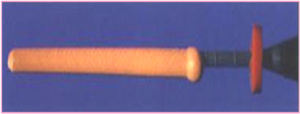Compaction Method:
Introduced by Mc spadden
– This method uses heat to decrease G.P viscosity and increase its plasticity
– The heat is created by rotating a compacting instrument in a slow-speed hp at 8,000-10,000 r.p.m alongside G.P cones inside the canal.
The compactor is made of spiraled 900 flutes same as H-file but in reverse direction.
It is used in St. canals since the blade breaks easily if it binds.
Steps : Enlarge the canal to 45 size in a step back preparation
: Master cone is selected
: Compactor is selected to the width and length of canal and is placed between GP and canal walls
: The reverse blades push the softened G.P forward and side ways .
Advantages:
Ease of selection and insertion of G.P
Economy of time
Disadvantages:
Cannot be used in narrow canals . Frequent breakage of blades .
Overfilling.
Shrinkage of the cooled filling .
Master cone based techniques would include cold lateral condensation, SystemB, the vertical compaction technique, single cone methods, Pac Mac, System A and lateral condensation followed by warm compaction.
Cold lateral condensation is the time-honored method of obturation that, while simple in application and concept, relies heavily on sealer to take up the spaces within the canal where the core obturation material never reaches. In practical reality, the apical half of many cold lateral condensation cases is single cone obturation as the spreader used for this method does not often reach the apical half of the root. Core obturation material is not moved by intention into the narrowing cross sectional anatomy of the prepared canal and does not fill all of the ramifications of the cleared canal space because the points are adapted together cold.
Chemically plasticized G.P
: G.P can be plasticized by chemical solvents like chloroform, eucalyptus oil, xylol.
: G.P becomes slightly viscous, highly plastic and
thus can be forced into fine, tortuous canals.
Procedure:
: In this method G.P cone is dipped in eucalyptus oil and the surface softened cones are used to coat the canal walls.
: Then the same cone is inserted and compressed with pluggers to the apical fit.
: This is followed by lateral condensation method
Disadvantage:
Overfilling
Shrinkage of the filling after setting
Chlorpercha is not used since it is carcinogenic.
Metal core obturation:
This includes obturating the canal with Ag cone, sectioned silver cone and St.Steel instrument .
Ag cone method:
Used in fine tortuous canals.
Once the 10 cone is cemented G.P is laterally condensed around the cone to ensure lateral seal
not used in the teeth to be restored with post core
Steps:
The Ag cone is checked for snug fit & confirmed by Rg.
It is placed in the canal by pliers or forceps and laterally sealed with GP cones.
Temporary restoration is given.
Sectional or split cone:
Indicated for the tooth that requires post and core
The cone is notched approximately 6mm from apical tip
The cone is cemented and wedged cone is rotated
until it breaks.
Advantages: Â Â Â Â Â Â Â Â Â Â Â Disadvantages:
Ag is stiffer than GP Â Â Â Â Â Poor lateral seal
hence used in fine      difficulty in retrieving
tortous canal Ag cone
St. Steel file method:
Used for fine, tortuous canals .
They are more rigid than Ag cones.
They can be inserted with greater ease.
Once the file is cemented, the handle is cut off with high speed bur
Then temporary restoration is given.

Thermoplasticized GP technique
1. Syringe insertion
a. Obtura
b. Inject-R-Fill, backfill
2. Solid-core carrier insertion
Thermafil and Densfil

The apparatus consists of an electrically heated syringe barrel and selection of needles ranging in size from 18-25 guage.
A special heater warms GP to flow under pressure and is discharged through a needle of suitable guage into R.C
Technique
GP is available in pellets that are inserted into the heated delivery system.
It is heated to approximately 1850C –2000C
The Obtura needle is introduced into the canal to the junction of the middle and apical third.
The GP is injected passively into the root canal.
It remains sufficiently plasticized up to 20 minutes.During this time the material is compacted to the canal walls.
Core carrier technique:
Thermafil plus
Here the metallic core is coated with G.P,
now a days flexible plastic carriers are available.
Master cone is selected
The carrier is placed in the canal to a predetermined depth and verified with radiograph.
This core carrier is heated in a controlled heating system
The top of carrier is cut off.
Temporary restoration is given.
Injection Technique:
Greenberg suggested the use of a pressure syringe to extrude cement into the canal.
E.g.: Hydron:
Rapid setting hydrophilic plastic material used as a r.c filling material without core.
Is a polymer of hydroxy ethyl methacrylate
Hydron sets in 10mins in r.c.
It is considered to be a biocompatible material
